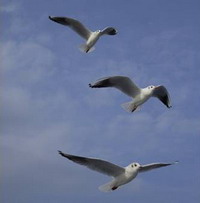Commuting Gulls
I’ve always been fascinated by the daily movements of gulls across the part of north Norfolk that I know so well. Ever since I can remember, looking up to the skies on a winter’s afternoon, I would see numbers of gulls in straggling V formations heading northwards towards the coast. In my razor sharp teens I would set up my telescope out of my bedroom window to watch and count the considerable formations of black-headed, common, herring, greater and lesser black-backed gulls steadily moving coastwards.

Gulls in flight
Of course, I wanted to know where these birds were heading, where they had been and what they were doing during the day. I still haven’t really got all the answers, but gradually a few observations have helped me to have some understanding of this daily commute as predictable as the sunrise and sunset.
The general pattern seems to be that of a night-time gull roost at the coast, probably Wells Harbour, but maybe other places too. Then, as I have now seen many times, a dawn or pre-dawn southward movement and dispersal. This is very noticeable at my house in Foulsham, where each morning flocks of common and black-headed gulls come in low across the fields from the north-west, often settling for a short time before moving on.
During the daytime, the gulls often display a more random movement, presumably roaming in search of good food sources. Then, early or mid-afternoon, the familiar V shaped formations start appearing with a steady northward bearing, back to the coast. There is at least one regular en-route stop-off, the lake at Holkham Park where gulls will pause for a brief wash before flying down the length of the serpentine lake towards the tidal sands of Wells.
Although the five species mentioned above are the most usual, other gulls will inevitably get caught up in these daily movements. Viewed from my stupendous back garden one early morning a few years ago in March were two perfect summer plumaged adult Mediterranean gulls, mixed in with the commons and black-heads. I am sure that keen gull-watchers would find yellow-legged, Caspian and maybe glaucous and Iceland gulls every now and then.
Some mysteries remain. Presumably in other areas, the gulls perform the same commuting movements to and from other roosts. It would be interesting to map the hinterland from each roost; how far is a gull prepared to fly for its scavenged lunch?; what observations have been made at the north Norfolk roost (numbers? What happens when it’s high tide?; And are there well-used flight lines overland, or is it just a random spread of flocks across a broad front (I think there are flight lines).
For me, a wintry Norfolk sunset is not complete without a gull or two.
Rob

Robert Yaxley
Rob Yaxley is Wild Frontier’s director and chief gull lover. His hobbies include obsessive pursuits such as counting the freckles on his children’s faces, adding up the numbers on number plates and collecting wooden rhinoceri under 10cm in length.
